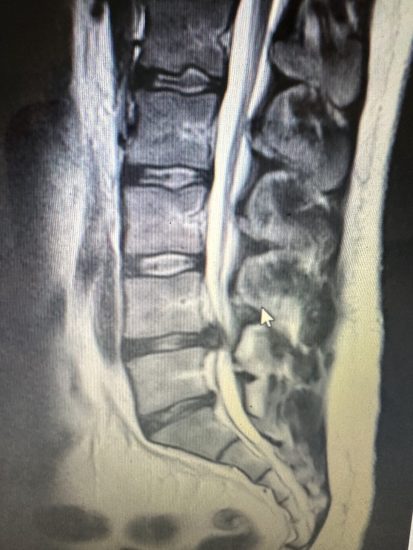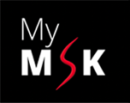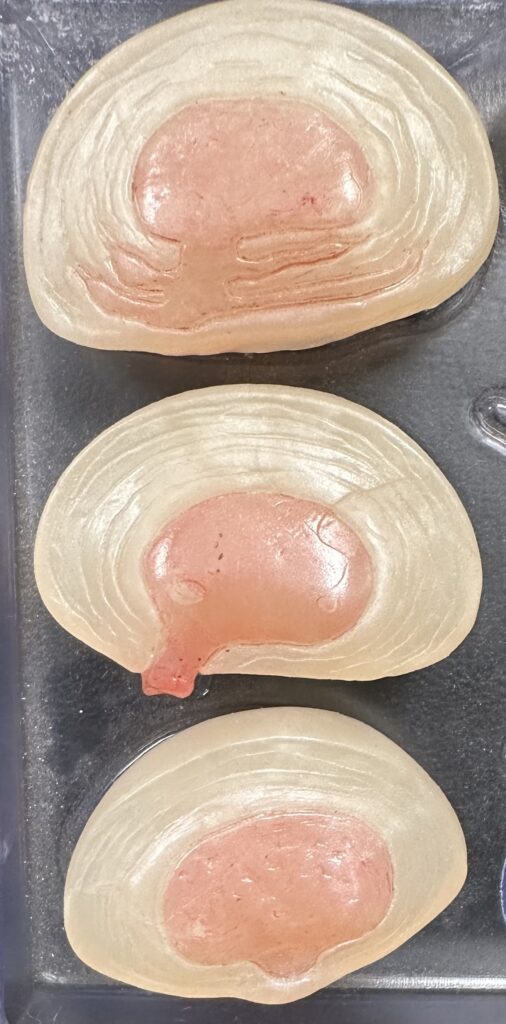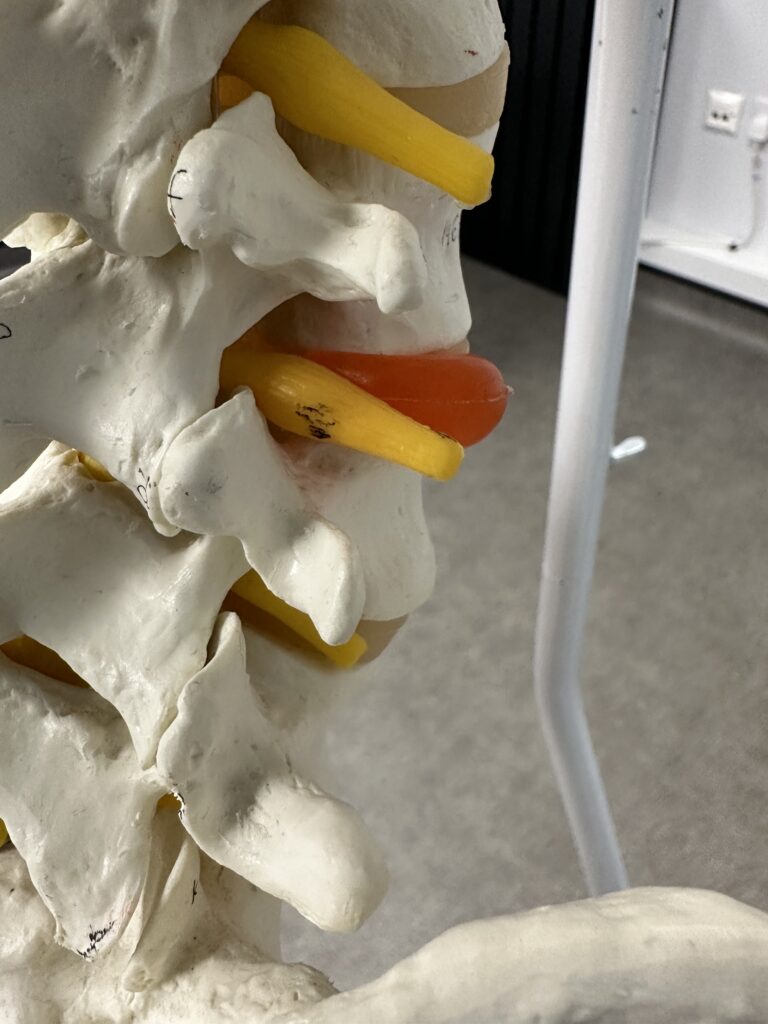
A prolapsed disc is also known as a slipped or herniated disc. It’s a condition that affects the discs in your spine. These discs sit between the vertebrae and act as shock absorbers and aid flexibility in the lumbar spine.
A prolapsed disc occurs when the soft gel like centre, called the Nucleus Pulposus, ‘bulges’ out through a tear in the tougher outer ring, called the annulus fibrosus. This can cause discomfort and pain as the disc material presses or applies pressure on the nerve roots or the spinal cord itself.
A prolapsed disc can occur anywhere in the spine but most commonly occurs in the lumbar region (lower back).
The lumbar area carries the most weight and has the most movement so is more prone to disc problems (especially L4/L5 and L5/S1) segments). Symptoms vary widely depending on the disc affected and the severity.
Patients may experience acute pain, numbness or weakness, often radiating to the arms or legs if nerve compression is involved.
The treatment of a prolapsed disc depends on symptom severity. It can range from conservative approaches, like manual or physical therapy and pain relief, to invasive procedures, like surgery.
In many instances, the symptoms of a prolapsed disc will improve gradually over time, as the body allows nature and time to heal the affected disc.
However, understanding the causes and potential preventative measures, such as maintaining good posture and incorporating regular exercise, is crucial for optimal spinal health.
Understanding Prolapsed Discs
Spine problems can be painful and debilitating.
Understanding basic spinal anatomy is important. Knowing what a prolapsed disc is and what causes it is key to knowing how to help heal yourself.
Anatomy of the Spine
The spine is a complex structure composed of bones called vertebrae, cushioned by intervertebral discs.
Each disc has a tough outer layer, the annulus fibrosus, and a gel-like inner substance, the nucleus pulposus.
The spine’s primary function is to support and enable movement, while also protecting the spinal cord.
What Is a Prolapsed Disc?
Despite its name, the disc does not actually “slip” but rather ruptures or bulges/herniates, leading to potential pain and discomfort. The degree of a prolapse can vary from minor bulges to complete ruptures.
Definition: A prolapsed disc is when the disc’s nucleus pushes out through a tear or weakness in the annulus.
Commonly affected area: The Lower back (Lumbar) or Neck (Cervical) region of the Spine.
Causes and Risk Factors
Several factors contribute to the development of a prolapsed disc. Age-related wear and tear is a significant cause, as discs ‘dry’ out and become less flexible over time, a phenomenon termed ‘Disc Degeneration/hydration’.
Persistent Lifting, bending, and twisting can strain the body. They can cause a disc to prolapse.
Traumatic injuries, being overweight, or leading a sedentary lifestyle can increase the risk.
Age: More likely after age 35.
Lifestyle Factors: Smoking and high BMI contribute to disc degradation.
Physical Stressors: Repeated Improper lifting and bending can cause acute disc injuries.
Symptoms of a Prolapsed Disc
Symptoms are often due to pressure on nearby nerves. Symptoms can vary in severity and type. This depends on the location and size of the herniated disc.
Common Symptoms
Pain: This is frequently the first indicator of a prolapsed disc. It may start suddenly or gradually and can be experienced in the lower back, neck, or at times in the arms or legs. The pain often gets worse at night or with certain movements.
Numbness or tingling: People might feel these sensations in areas served by the affected nerves. These areas are termed dermatomes. These areas include the shoulders, back, arms, hands, legs, or feet.
Muscle weakness may occur. It is a decrease in strength in the muscles innervated by the affected nerves. This decrease in strength may make it difficult to perform everyday tasks.
Complications
Cauda Equina Syndrome is rare but serious. It causes severe lower back pain, bladder and bowel problems, and sometimes loss of feeling in the groin. It is considered a medical emergency and requires immediate surgical treatment.
Sciatica: When a prolapsed disc presses on the Sciatic nerve, it can cause a sharp, shooting pain that extends from the buttocks down to the legs, termed Sciatica. This condition might also cause numbness or tingling along the affected leg and foot.
For effective symptom relief, painkillers are commonly used; however, they often do not address the underlying condition.
Continual symptoms like numbness, tingling, and weakness need urgent evaluation
If there’s any loss of bladder or bowel control, get immediate medical help to prevent potential permanent damage to the spinal nerves.
Diagnosing a Prolapsed Disc
Doctors diagnose a prolapsed disc with a thorough clinical exam. They often also use imaging tests to confirm the injury. These assessments are vital for developing an effective treatment plan.
Clinical Examination
A clinical evaluation for a prolapsed disc starts with a medical history. The patient describes their pain, when it happens, and the nature of their symptoms. The clinician often follows this with a physical exam involving palpation and spinal movements
Specific tests may be performed to assess nerve function and to determine if a nerve root is affected by the prolapsed disc.
Leg reflexes, muscle strength, and sensation are often also checked. This helps to see if the spinal cord or nerve roots are being compressed.
Imaging Tests
When the initial evaluation suggests a prolapsed disc, imaging tests may be organised to gather further information
An MRI scan is a common diagnostic tool. It provides a detailed image of the body’s soft tissues, including the spinal canal and nerve roots.
The MRI also aids in finding the location and size of disc herniation. They also show if neural elements are involved.
An X-ray might rule out other causes of back pain, like fractures or bone spurs. It cannot however, show a prolapsed disc but can give a clue to a herniated disc if there is ‘reduced disc space‘ mentioned on the Xray Report.
Non-Surgical Treatment Options
Non-surgical treatment for a prolapsed disc aims to reduce pain and promote healing
It also aims to build the strength and flexibility needed to go back to normal activities.
Injections for Prolapsed Discs
Epidural steroid injections may be considered to provide relief from the pain associated with a prolapsed disc.
These injections deliver anti-inflammatory medication directly to the affected area around the spinal nerves.
They often help patients with pain relief in order to commence physical therapy and allow some return to normality.
Medication and Pain Relief
Medication plays a pivotal role in the management of prolapsed disc symptoms. Pain relief medications are commonly used. They include ibuprofen and naproxen. They are anti-inflammatory drugs that reduce pain and inflammation.
In some cases, stronger pain medication like codeine may be prescribed under careful supervision.
Surgical Interventions
Surgical intervention can be taken into consideration when non-surgical treatments do not help.
These procedures aim to alleviate nerve root compression and are generally reserved for patients experiencing significant pain, neurological symptoms, or both.
Indications for Surgery
Doctors consider surgery if a patient has persistent pain not helped by conservative treatment, or if there is evidence of nerve dysfunction. This evidence includes weakness, numbness, or cauda equina syndrome.
Cauda Equina Syndrome is a serious condition. Lower spinal canal compression causes loss of function in the nerves serving the lower limbs and bladder. An urgent spinal decompression is often required to prevent irreversible damage to the nerves supplying the bladder leading to irreversible incontinence.
Types of Surgery
There are various surgical options for treating a prolapsed disc and relieving pressure on the affected nerve roots. Popular methods include:
Microdiscectomy: This minimally invasive procedure involves the removal of the portion of the disc that is pressing on a nerve root. It allows for a quicker recovery and is associated with less postoperative pain.
Spinal Fusion: When the disc space is reduced with severe damage of the disc, a fusion surgery may be performed to join two or more vertebrae together, limiting movement and preventing nerve compression.
- Spacer device: Often used to release pressure on a nerve and an alternative to Spinal fusion where a spacer replaces the damaged disc.
Each surgery type has its own benefits and risks. The decision on which approach is followed depends on each person’s individual circumstances.
Recovery and Risks
Recovery time after a prolapsed disc surgery can vary but is generally quite structured.
The first four to six weeks are important, with recommendations to avoid twisting or lifting.
Once this initial period has passed, a gradual return to activity is often the course of action, with full recovery anticipated by three months.
This is not always the case however and surgery should always be the last resort after other approaches are tried first
Lifestyle and Prevention
Effective management and prevention of a prolapsed disc can be significantly influenced by lifestyle choices.
Maintaining an appropriate body weight, engaging in regular exercise, and being mindful of posture can all contribute to spinal health.
Maintaining a Healthy Weight
Carrying extra weight, especially around the midsection, can strain the spine. It can also lead to a prolapsed disc.
Obesity is a risk factor for spinal issues.
Exercise and Physical Fitness
Regular exercise is essential for spinal health, as it helps to keep the back muscles strong and flexible.
This, in turn, supports the spine and lessens the likelihood of a disc prolapse. It is best to include a mix of activities.
These include walking or swimming. Also, include targeted exercises for the core and back muscles. This will keep you fit and active.
Posture and Ergonomics
Maintaining good posture and understanding ergonomics can prevent unnecessary strain on the spine during normal activities, lifting, or even when driving.
Using chairs with lumbar support helps. So does setting up workstations to encourage a neutral spinal position.
Managing Chronic Symptoms
Chronic symptoms of a prolapsed disc can significantly impact daily life, requiring effective strategies for pain management and emotional support to cope with the condition. These may involve a combination of medical treatments and lifestyle adjustments.
Frequently Asked Questions
In addressing the complexities of a prolapsed disc, common enquiries tend to centre on symptoms, management, and recovery. This section aims to answer some of your questions:
What are the typical symptoms of a disc prolapse?
Symptoms generally involve pain in the affected area, which can often radiate to different parts of the body, such as the arms or legs. Numbness or a tingling sensation in the limbs is also frequent.
How can a slipped disc be repositioned?
Non-surgical treatments, such as physiotherapy or specific exercises, may help the disc naturally return to its position although a perfect return to pre injury levels is rare. In more severe cases, Surgical intervention might be required.
What are the main causes of a disc prolapse?
A disc prolapse can arise from strain caused by lifting heavy objects, sudden movements, or as part of the natural ageing process. Factors like obesity or regular physical activity can also contribute.
Can a disc prolapse heal without surgical intervention?
Yes, many prolapsed discs may heal over time with conservative treatment methods, including rest, physiotherapy, and pain management. Surgery is typically considered when other treatments have not provided relief.
What is the difference between a herniated disc and a disc prolapse?
The two terms are often used Synonymously. They essentially refer to the same concept where disc material ruptures through the outer layer of the Annulus (outer fibres of the disc)
What treatment options are available for a prolapsed disc?
Treatment options include over-the-counter pain relief and anti-inflammatory drugs and Injections. They also include physical therapy. In severe cases, they include surgical options like microdiscectomy or laminectomy.
At MyMSK Clinic in Manchester we offer Injections for Prolapsed Disc. Caudal Epidural injections, Spinal Injections or Prolotherapy can often be used to reduce pain.
First we do a through examination and before proceeding with treatment.
If you are suffering from Pain due to a Prolapsed disc contact us at 0333 772 9655 or visit our Booking Page to Arrange an Appointment






